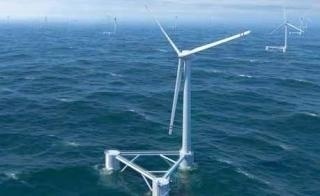Mar 11 2016
A team of researchers that includes two engineers from the University of Massachusetts Amherst is developing a new mooring system for floating offshore wind turbines that uses an integrated network of anchors and lines to hold dozens or even hundreds of turbines in place in the ocean in industrial-scale, offshore wind farms.
 Researchers from UMass Amherst and others will evaluate the feasibility and design implications of highly variable soil conditions on the ocean floor for securing anchors, the layout of the wind farms and the complicated dynamics that cause loads on the anchors. Credit: UMass Amherst/Sanjay Arwade
Researchers from UMass Amherst and others will evaluate the feasibility and design implications of highly variable soil conditions on the ocean floor for securing anchors, the layout of the wind farms and the complicated dynamics that cause loads on the anchors. Credit: UMass Amherst/Sanjay Arwade
Civil and environmental engineers Sanjay R. Arwade and Don J. DeGroot from UMass Amherst, along with Charles P. Aubeny from Texas A&M University and Melissa Landon of the University of Maine, are conducting the research with a three-year, $497,341 grant from the National Science Foundation. The funding comes jointly from the NSF’s Grant Opportunities for Academic Liaison with Industry and Geotechnical Engineering programs.
The research team is working with Vryhof Anchors, an international industrial partner that is a world leader in producing offshore anchoring systems, including the one used by the world’s first floating offshore wind turbine in Norway.
This industrial collaboration is particularly important to the success of the project since Vryhof can assist Arwade and DeGroot with assessment of the complex installation, staging and cost-estimating aspects of the project and will help guide the research in directions that will be directly applicable to industry needs.
The principal goal of the research is to develop offshore floating wind farms where the individual floating wind turbines are moored using a networked series of anchors and cables that hold the entire wind farm in place. Currently, each floating wind turbine has its own individual anchoring system. The proposed networked system would save money and require fewer anchors and geotechnical site investigations, the researchers say.
In order to accomplish this goal, the researchers will have to evaluate the feasibility and design implications of highly variable soil conditions on the ocean floor for securing the anchors, the layout of the wind farms and the complicated dynamics that cause loads on the anchors. In addition, the scientists will be developing wind and wave models for the best placement and orientation of the wind farms.
“This project is an exciting opportunity to bring together structural dynamics and geotechnical engineering in new ways to support national renewable energy goals by potentially lowering capital costs associated with offshore wind development,” Arwade says.
The team is also looking at the best designs for the mooring lines, the connections between the floating wind turbine and the anchors, says Arwade. They will also develop three-dimensional models for measuring the behavior of the anchors on the sea floor and the best designs for the multiple cables attached to each anchor.
“At each level, the floating structure and the anchor, there are challenging nonlinear and dynamic issues that force this research to work at the cutting edge of geotechnical engineering and offshore structural engineering,” Arwade says. “For that reason it also provides a perfect opportunity to educate the next generation of researchers in the area of offshore wind energy, and is supporting a doctoral student towards that end.”
It is expected that this project may hasten progress toward the goal of generating 20 percent of U.S. energy needs from wind power by potentially reducing the cost of building offshore wind farms by a significant margin.